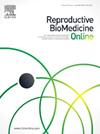Adipokines level in plasma, hypothalamus, ovaries and adipose tissue of rats with polycystic ovary syndrome
IF 3.7
2区 医学
Q1 OBSTETRICS & GYNECOLOGY
引用次数: 0
Abstract
Research question
Do the levels of adipokines (adiponectin, apelin, chemerin and vaspin) in plasma, hypothalamus, ovaries and periovarian adipose tissue differ during polycystic ovarian syndrome (PCOS)?
Design
The PCOS was induced in rats by oral administration of non-steroidal aromatase inhibitor letrozole. To determine the plasma levels of adiponectin, apelin, chemerin and vaspin enzyme-linked immunosorbent assays were carried out. To assess the expression (gene and protein) and immunolocalization of these adipokines and their receptors, namely Adipor1 and Adipor2 for adiponectin, Aplnr for apelin, Ccrl2, Cmklr1 and Gpr1 for chemerin and Grp78 for vaspin in the hypothalamus, real-time polymerase chain reaction, and Western blot and immunohistochemistry were used to analyse ovaries and periovarian adipose tissue respectively.
Results
In PCOS, the plasma level of adiponectin decreased (P = 0.0003), whereas apelin, chemerin and vaspin increased (P ≤ 0.0479). Moreover, PCOS modulates the expression of adipokines and their receptors in the hypothalamus, ovaries and periovarian adipose tissue compared with healthy rats (P ≤ 0.487).
Conclusions
A strong relationship was found between PCOS and adipokines, which suggests that adipokines may be a biomarker of PCOS.
多囊卵巢综合征大鼠血浆、下丘脑、卵巢及脂肪组织中脂肪因子水平的研究。
研究问题:多囊卵巢综合征(PCOS)患者血浆、下丘脑、卵巢和子膜脂肪组织中的脂肪因子(脂联素、apelin、趋化素和vaspin)水平是否不同?设计:口服非甾体芳香化酶抑制剂来曲唑诱导大鼠多囊卵巢综合征。采用酶联免疫吸附法测定血浆脂联素、apelin、趋化素和vaspin的水平。为了评估这些脂肪因子及其受体,即脂联素Adipor1和Adipor2, applnr,趋化素Ccrl2, Cmklr1和Gpr1,血管素Grp78在下丘脑的表达(基因和蛋白)和免疫定位,分别采用实时聚合酶链反应,Western blot和免疫组织化学对卵巢和子膜脂肪组织进行分析。结果:PCOS患者血浆脂联素水平降低(P = 0.0003),apelin、chemerin、vaspin升高(P≤0.0479)。与健康大鼠相比,PCOS可调节下丘脑、卵巢和子膜脂肪组织中脂肪因子及其受体的表达(P≤0.487)。结论:脂肪因子与多囊卵巢综合征有密切关系,提示脂肪因子可能是多囊卵巢综合征的生物标志物。
本文章由计算机程序翻译,如有差异,请以英文原文为准。
求助全文
约1分钟内获得全文
求助全文
来源期刊

Reproductive biomedicine online
医学-妇产科学
CiteScore
7.20
自引率
7.50%
发文量
391
审稿时长
50 days
期刊介绍:
Reproductive BioMedicine Online covers the formation, growth and differentiation of the human embryo. It is intended to bring to public attention new research on biological and clinical research on human reproduction and the human embryo including relevant studies on animals. It is published by a group of scientists and clinicians working in these fields of study. Its audience comprises researchers, clinicians, practitioners, academics and patients.
Context:
The period of human embryonic growth covered is between the formation of the primordial germ cells in the fetus until mid-pregnancy. High quality research on lower animals is included if it helps to clarify the human situation. Studies progressing to birth and later are published if they have a direct bearing on events in the earlier stages of pregnancy.
 求助内容:
求助内容: 应助结果提醒方式:
应助结果提醒方式:


